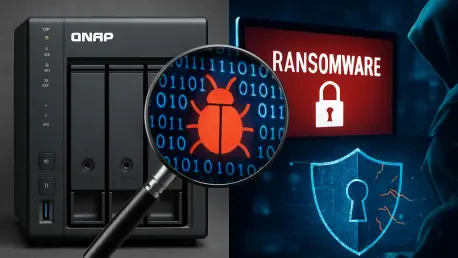In an era where data breaches and cyber threats loom large over organizations of all sizes, a newly disclosed vulnerability in widely used backup software has raised significant concerns among IT professionals and security experts alike. QNAP Systems, a prominent provider of network-attached storage solutions, recently announced a critical flaw in their NetBak Replicator software, identified as CVE-2025-57714. This vulnerability, affecting version 4.5.x on Windows systems, exposes systems to potential unauthorized code execution by local attackers, which could lead to severe consequences like privilege escalation and persistent access. The discovery of this flaw serves as a stark reminder of the importance of robust security measures in software that handles critical operations such as backups. As cybercriminals continue to exploit even the smallest gaps in defenses, understanding the nature of this issue and the steps taken to address it becomes paramount for organizations relying on such tools to protect their data.
Unveiling the Vulnerability and Its Risks
The core issue with NetBak Replicator 4.5.x stems from an unquoted search path flaw, a well-documented security weakness in Windows environments. This vulnerability arises when the operating system fails to properly handle directory paths with spaces, allowing attackers to manipulate the search order for executables. By placing a malicious file in a higher-priority directory, a local attacker can trick the system into running unauthorized code under the same privileges as the legitimate backup service. Such a flaw is particularly alarming because it does not require sophisticated skills or remote access—merely local access to a standard user account is enough. This simplicity heightens the risk for organizations, especially those operating in shared environments like terminal servers or virtual desktop infrastructures where multiple users interact with the same system. The potential for attackers to install backdoors or escalate privileges underscores the urgency of addressing this gap before it can be exploited on a wider scale.
Beyond the technical details, the implications of this vulnerability are far-reaching for businesses that depend on NetBak Replicator for safeguarding critical data. Once exploited, attackers could disrupt backup integrity, compromise sensitive information, or use the elevated access as a springboard for lateral movement across networks. This risk is amplified in multi-user setups where varying levels of access might inadvertently provide a foothold for malicious actors. Security researchers have pointed out that while unquoted search path issues are not new, their persistence in modern software highlights gaps in development practices that must be addressed. For enterprises, the challenge lies not only in mitigating this specific flaw but also in recognizing the broader pattern of similar vulnerabilities that could emerge in other tools. The ease of exploitation combined with the severe outcomes necessitates a proactive stance to prevent potential breaches before they materialize into significant losses.
QNAP’s Response and Mitigation Strategies
In a swift move to counter the threat posed by CVE-2025-57714, QNAP has released an updated version of NetBak Replicator, specifically 4.5.15.0807 and later, which addresses the unquoted search path flaw. This patch eliminates the vulnerability by ensuring proper handling of file paths, thereby preventing attackers from executing malicious code through manipulated directories. Organizations using the affected software are strongly urged to update immediately to protect their systems from potential exploitation. The timely response from QNAP demonstrates a commitment to user security, yet it also serves as a reminder that relying solely on vendor patches is not a complete solution. Enterprises must integrate this update into their broader cybersecurity framework, ensuring that all instances of the software across their infrastructure are brought up to date without delay. Failure to do so could leave systems exposed, particularly in environments where updates are not uniformly applied.
However, patching alone does not fully mitigate the risks associated with such vulnerabilities, especially in complex or shared computing environments. Adopting a defense-in-depth approach is critical to bolster security beyond the immediate fix. This includes implementing strict access controls to limit local administrator privileges, reducing the attack surface for potential exploits. Additionally, deploying host-based intrusion detection systems can help identify unusual process launches that might indicate an attempted exploitation. Regular security audits focusing on path configurations and permissions are also recommended to catch similar issues before they become exploitable. For organizations, integrating vulnerability scanning into change-management processes ensures that emerging threats are detected early. By combining these proactive measures with the patched software, businesses can significantly reduce the likelihood of falling victim to attacks leveraging flaws like the one recently addressed by QNAP.
Broader Implications for Cybersecurity Practices
The discovery of this flaw in NetBak Replicator sheds light on a persistent challenge within the software industry: ensuring secure coding practices to eliminate well-known attack vectors. Despite being a recognized issue for years, unquoted search path vulnerabilities continue to surface, pointing to the need for more rigorous development standards and testing protocols. Security experts, including those who identified this flaw, emphasize that developers must prioritize path-handling checks to prevent such oversights. This incident aligns with broader cybersecurity trends advocating for continuous monitoring and proactive patching as essential components of organizational defense. For companies relying on backup solutions, the integrity of these tools is non-negotiable, as they often serve as the last line of defense against data loss. Addressing flaws like CVE-2025-57714 requires not just technical fixes but a cultural shift toward prioritizing security at every stage of software creation and deployment.
Moreover, the diversity of environments where NetBak Replicator is used—from single-user setups to complex multi-administrator systems—highlights the necessity for tailored security policies. Organizations must assess their specific use cases to determine the level of risk posed by local access vulnerabilities. This might involve segmenting access rights or enhancing monitoring in shared systems to detect insider threats or compromised accounts. Beyond immediate mitigation, there is a clear call for enterprises to maintain up-to-date software across all utilities, not just those directly affected by known flaws. The incident serves as a cautionary tale about the cascading effects of seemingly minor vulnerabilities in critical tools. By fostering a mindset of vigilance and investing in layered defenses, businesses can better protect themselves against both current threats and those that may emerge in the coming years, ensuring resilience in an ever-evolving threat landscape.
Path Forward After the Patch
Reflecting on the resolution of this critical vulnerability, QNAP took decisive action by releasing a patch for NetBak Replicator that closed the dangerous gap exploited through unquoted search paths. The response was prompt, providing organizations with the means to secure their systems against local attackers seeking unauthorized access or privilege escalation. Security teams across various sectors applied the update to version 4.5.15.0807 and beyond, safeguarding their backup operations from potential compromise. Alongside this fix, many adopted additional protective measures, recognizing that a single patch could not address every facet of risk in dynamic IT environments. This incident prompted a reevaluation of access policies and detection mechanisms to fortify defenses against similar issues that had previously gone unnoticed.
Looking ahead, the next steps for organizations involve a commitment to sustained vigilance and proactive security enhancements. Enterprises are encouraged to embed regular software audits and vulnerability assessments into their operational routines, ensuring no stone is left unturned in the pursuit of system integrity. Strengthening access controls remains a priority, as does the deployment of advanced monitoring tools to catch anomalies indicative of exploitation attempts. The broader cybersecurity community views this event as a catalyst for advocating stronger development practices industry-wide, pushing for standards that would minimize the recurrence of such flaws. By learning from this episode and applying comprehensive strategies, businesses aim to not only secure their current infrastructure but also build resilience against future threats, maintaining trust in the tools that protect their most valuable data assets.









